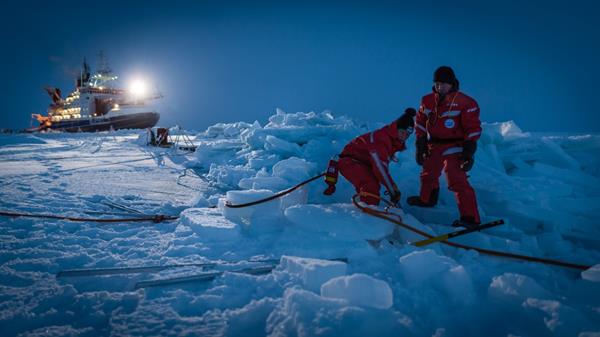
A world-first to serve polar expedition
TORONTO – Nanosatellite telecommunication company Kepler Communications announced today it has demonstrated delivering over 100Mbps connectivity service in the Arctic region to the German icebreaker Polarstern.
The ship is located around 85°N and is the home to the MOSAiC scientific expedition (pictured). The demonstration marks the first time in history that the central Arctic is successfully connected through a high-bandwidth satellite network.
Kepler has two polar-orbiting satellites which are being used to transfer data for scientists taking part in MOSAiC, which Kepler says is the most extensive research expedition ever to the North Pole.
MOSAiC is an international expedition consisting of hundreds of scientists and operations crew, which will remain locked into the Arctic ice sheet to study the environment. The team will spend the next 12 months drifting along with the ice sheet, with the purpose of the mission being to take the closest look ever at the effects of climate change on the Arctic, says the Kepler release.
The Polarstern, which is positioned well outside the range of traditional high-throughput satellites, is equipped with the world’s only high-bandwidth nanosatellite data link delivered from low-Earth orbit (LEO) that is available in the Arctic, via Kepler. The company is providing 100x higher data speeds when its satellites pass over the vessel that would otherwise not be possible. This improved data transfer capability means scientists can share large data files between ship and shore, improving the ability to share, analyze, and disseminate information.
“Our Global Data Service provides a cost-effective means to transfer large data volumes that will be gathered over the course of MOSAiC,” said Kepler CEO Mina Mitry, in the press release. “Rather than only storing data locally and analyzing once physical storage can be sent back with supply vessels, we are giving scientists the ability to continuously transfer test and housekeeping data sets over our unique LEO satellite network.”
"The high polar regions are the last frontiers of the globe where high bandwidth data connections could not be established so far,” added professor Markus Rex, MOSAiC project leader. “Kepler's new Global Data Service now enables us to send back bulk data, including key data files for monitoring the status of instruments together with experts at home. This will contribute to the success of MOSAiC."
The MOSAiC expedition began when the Polarstern set sail from Norway this past September and will continue for more than a year. Findings from the mission will help better assess the future of Earth’s climate, and provide valuable information to help fight climate change.
The expedition involves the joint efforts of 19 countries around the world and with over US$158 million in funding, it features the most advanced technology on a research icebreaker and is the largest expedition to the North Pole ever in history.
Kepler is the world's only provider of high-bandwidth satellite services in the poles and aboard the Polarstern, it has demonstrated data rates of 38 Mbps downlink and 120 Mbps uplink to a 2.4m Ku-band VSAT (Very Small Aperture Terminal).



